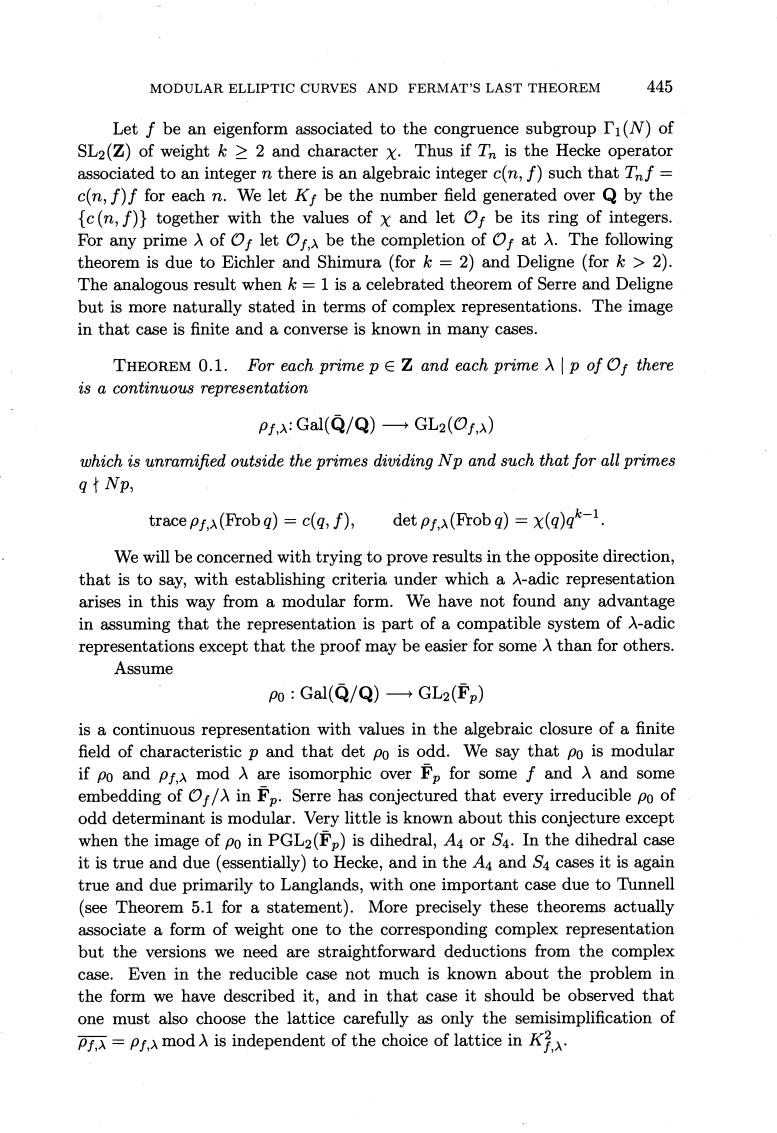正在加载图片...

MODULAR ELLIPTIC CURVES AND FERMAT'S LAST THEOREM 445 Let f be an eigenform associated to the congruence subgroup ri(N)of SL2(Z)of weight k >2 and character x.Thus if Tn is the Hecke operator ass ociated to an integer n there is an algebraic integer c(n,f)such that Tf c(n,f)f for each n.We let Kt be the number field generated over Q by the fc(n,f)}together with the values of x and let Of be its ring of integers. For any prime A of Of let Ofa be the completion of O at A.The following theorem is due to Eichler and Shimura (for =2)and Deligne(for> 2) The analogous result when k=1 is a celebrated theorem of Serre and Deligne but is more naturally stated in terms of complex representations.The image in that case is finite and a converse is known in many cases. THEOREM 0.1.For each prime pEZ and each prime p of Of there is a continuous representation Pf:Gal(Q/Q)-GL2(Of.) which is unramified outside the primes dividing Np and such that for all primes gt Np, tracepf(Frobq)=c(q,f), det(Frobq)=x(g)qk-1 We will be concerned with trying to prove results in the opposite direction, that is to say,with establishing criteria under which a A-ad representation arises in this way from a modular form.We have not found any advantage in assuming that the representation is part of a compatible system of A-adic representations except that the proof may be easier for some A than for others. Assume po:Gal(Q/Q)一GL2(Fp) is a continuous representation with values in the algebraic closure of a finite field of characteristic p and that det po is odd.We say that po is modular if po and pfa mod A are isomorphic over Fp for some f and A and some embedding of /A in Fp.Serre has conjectured that every irreducible po of odd determinant is modular.Very little is known about this conjecture except when the image of po in PGL2(Fp)is dihedral,A or S4.In the dihedral it is true and due (essentially)to Hecke.and in the A.and S4 cases it is again true and due primarily to Langlands,with one important case due to Tunnell (see Theorem 5.1 for a statement) More precisely these theorems actually associate a form of weight one to the corresponding complex representation but the versions we need are straightforward deductions from the complex Even in the reducible case not much is known about the problem in the form we have described it,and in that case it should be observed that one must also choose the lattice carefully as only the semisimplification of =mod is independent of the choice of lattice inKMODULAR ELLIPTIC CURVES AND FERMAT'S LAST THEOREM 445 Let f be an eigenform associated to the congruence subgroup Fl(N) of SL2(Z) of weight k 2 2 and character X. Thus if Tn is the Hecke operator associated to an integer n there is an algebraic integer c(n, f) such that Tnf = c(n,f )f for each n. We let Kf be the number field generated over Q by the {c (n, f)) together with the values of x and let Of be its ring of integers. For any prime X of Of let Of,x be the completion of Of at A. The following theorem is due to Eichler and Shimura (for k = 2) and Deligne (for k > 2). The analogous result when k = 1is a celebrated theorem of Serre and Deligne but is more naturally stated in terms of complex representations. The image in that case is finite and a converse is known in many cases. THEOREM 0.1. For each prime p E Z and each prime X I p of Of there is a continuous representation which is unramijied outside the primes dividing Np and such that for all primes 4 t NP, We will be concerned with trying to prove results in the opposite direction, that is to say, with establishing criteria under which a A-adic representation arises in this way from a modular form. We have not found any advantage in assuming that the representation is part of a compatible system of A-adic representations except that the proof may be easier for some X than for others. Assume PO : Gal(Q/Q) +GL2(Fp) is a continuous representation with values in the algebraic closure of a finite field of characteristic p and that det po is odd. We say that po is modular if po and pf,x mod X are isomorphic over F, for some f and X and some embedding of Of/X in F,. Serre has conjectured that every irreducible po of odd determinant is modular. Very little is known about this conjecture except when the image of po in PGL~(F,) is dihedral, A4 or S4.In the dihedral case it is true and due (essentially) to Hecke, and in the A4 and S4cases it is again true and due primarily to Langlands, with one important case due to Tunnel1 (see Theorem 5.1 for a statement). More precisely these theorems actually associate a form of weight one to the corresponding complex representation but the versions we need are straightforward deductions from the complex case. Even in the reducible case not much is known about the problem in the form we have described it, and in that case it should be observed that one must also choose the lattice carefully as only the semisimplification of = pf,~mod X is independent of the choice of lattice in Kf2,x